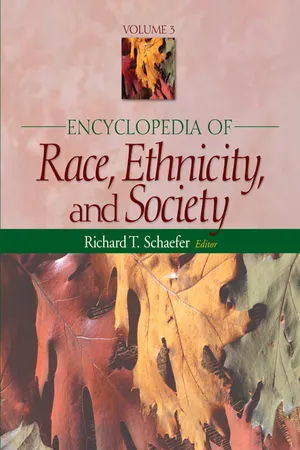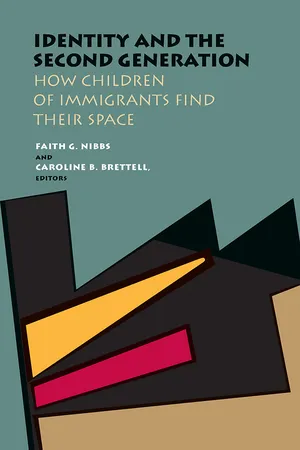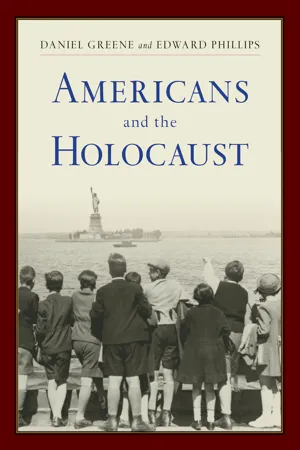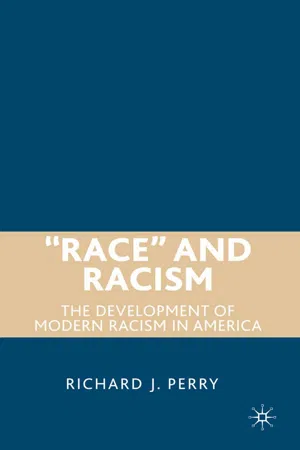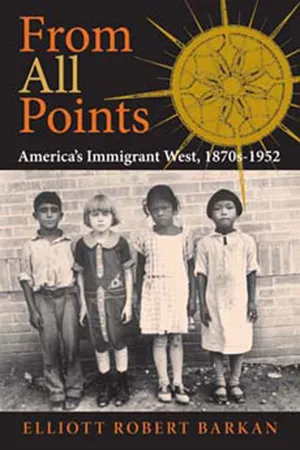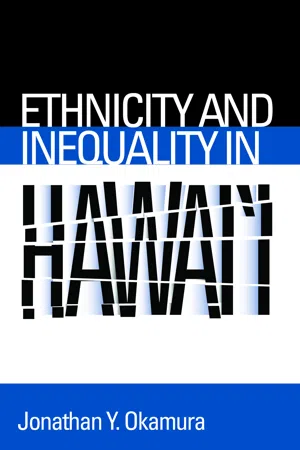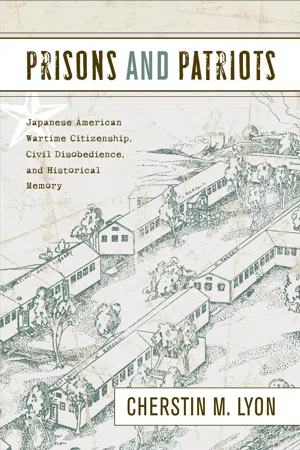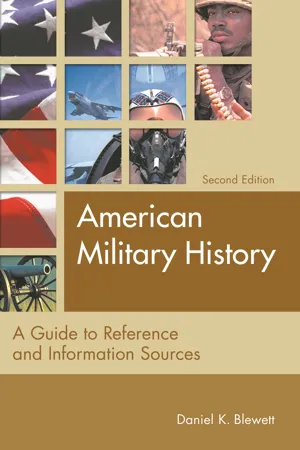History
Japanese Americans in WW2
During World War II, Japanese Americans faced discrimination and were subjected to forced relocation and internment by the United States government. This unjust treatment was a result of widespread anti-Japanese sentiment following the attack on Pearl Harbor. Despite this adversity, many Japanese Americans served with distinction in the military, and their resilience and contributions have been recognized in subsequent years.
Written by Perlego with AI-assistance
Related key terms
1 of 5
12 Key excerpts on "Japanese Americans in WW2"
- eBook - PDF
- Richard T. Schaefer(Author)
- 2008(Publication Date)
- SAGE Publications, Inc(Publisher)
For example, some Japanese Americans clearly recall their experiences being interned during World War II, but the youngest Japanese Americans, who may be bira- cial, might have no knowledge or understanding of the internment. Some Japanese Americans are recent immigrants, but others have U.S. family histories that date back to the 1800s. Many Japanese Americans are used to living and functioning in predominantly White environments such as neighborhoods, schools, and industry, and have become accustomed to being one of few ethnic minorities. Some of these individuals may not often reflect on their ethnicity, but others are much more active in their interest in and desire to learn more about the Japanese American experience. Gayle Y. Iwamasa See Appendix A; Appendix B See also Acculturation; Alien Land Acts; Asian Americans; Asian American Studies; Hawai‘i, Race in; Immigration, U.S.; Internment Camps; Issei; Japanese American Citizens League; Model Minority; Nikkeijin; Nisei; Pacific Islanders Further Readings Daniels, Roger. 1993. Prisoners Without Trial: Japanese Americans in World War II. New York: Hill and Wang. Fugita, Stephen S. and David J. O’Brien. 1991. Japanese American Ethnicity: The Persistence of Community. Seattle: University of Washington Press. Hohri, William. 1988. Repairing America: An Account of the Movement for Japanese American Redress. Pullman: Washington State University Press. Kimura, Yukiko. 1988. Issei: Japanese Immigrants in Hawaii. Honolulu: University of Hawai‘i Press. Matsumoto, Valerie. 1993. Farming the Home Place: A Japanese American Community in California, 1919–1982. Ithaca, NY: Cornell University Press. Nakano, Mei. 1990. Japanese American Women: Three Generations, 1890–1990. Berkeley, CA: National Japanese American Historical Society. Takagi, Dana 1994. “Japanese American Families.” In Minority Families in the United States: A Multicultural Perspective, edited by R. L. Taylor. Englewood Cliffs, NJ: Prentice Hall. Weglyn, Michi. - Available until 23 Dec |Learn more
Asian America
Chinese and Japanese in the United States since 1850
- Roger Daniels(Author)
- 2011(Publication Date)
- University of Washington Press(Publisher)
These last changes were, perhaps, inherent in the long evolution from slavery, segregation, and ostracism toward real freedom, integration, and equality, but their pace was distinctly quickened by the process of fighting a war against forces that were clearly and unambiguously racist. That the struggle against the Axis produced one of the grossest violations of the constitutional rights of American citizens in our history—the incarceration of more than 70,000 American citizens of Japanese ancestry who were guilty of nothing but having the wrong kind of genes—is an ironic and disgraceful aspect of a war whose stated objective was freedom. But history does not move in straight lines, and its actors often play varied roles. Thomas Jefferson, who proclaimed that all men are created equal, was a slave holder; Franklin Roosevelt, who proclaimed the Four Freedoms, ordered Japanese Americans into concentration camps. Wars often have social effects undreamed of by those who direct them. Just as the American Civil War, despite Abraham Lincoln's initial indifference, eventually became a war to make men free, the war that began at Pearl Harbor eventually transformed the legal, social, and psychological position of Asians in American society. Asian Americans and World War II 187 For Overseas Chinese accustomed to playing a role in the politics of China, the Sino-Japanese struggles of the 19308 seemed at first just another episode in modern China's long time of troubles. As early as 1931 Chinese Americans were staging peaceful anti-Japanese demon-strations in cities across the United States. But as the intermittent fighting continued, especially after 1937 when there were large-scale battles in Shanghai and elsewhere, support for the Chiang Kai-shek regime grew steadily. Between 1937 and 1945 some $56 million was raised among Chinese in America in support of China's war effort. - eBook - PDF
Personal Perspectives
World War II
- Timothy C. Dowling(Author)
- 2005(Publication Date)
- ABC-CLIO(Publisher)
military. The army set up fifteen “reprocessing” centers to handle the ethnic Japanese, who would then be sent on to camps in the center of the United States, away from the “danger zone.” Arthur Doi, later in the 442nd Regimental Combat Team, summed up the process: “American ‘patriots’ ignore[d] the U.S. Constitution for political, economic, and social gains. They react[ed] to their and others’ prejudices, ignorances, and racism to try and attain their gains. Politicians watch[ed] where the crowd [was] going and [got] in front as if they were the leaders” (Doi 1991). 214 B PERSONAL PERSPECTIVES: WORLD WAR II Japanese Americans interned at Santa Anita, Arcadia, California, ca. 1942. (Corbis) www.abc-clio.com ABC-CLIO 1-800-368-6868 Those affected by the order were given little time to comply. They were neither told where they were going nor allowed to bring much in the way of possessions. The result was “near-panic,” as thousands of ethnic Japanese tried to deal with homes, cars, and other possessions. “Human vultures” de- scended, offering insultingly low prices for furniture, appliances, and any- thing else (Okihiro 1999, 26). One Nisei remembered that “some . . . smashed their stuff, broke it up, right before the buyers’ eyes because they offered such ridiculous prices” (Okihiro 1999, 26). A few Japanese Americans believed they were being taken to face a firing squad. Most knew differently, but leaving was still painful. Tomiko Sato wrote that “evacuation meant leaving my home and friends. . . . As I trudged The Japanese American Experience in World War II B 215 This store in Oakland, California, was closed following orders that all Japanese Americans evacuate to internment camps. The owner, a University of California gradu- ate of Japanese descent, placed the “I Am an American” sign on the storefront the day after Pearl Harbor was attacked in December 1941. (National Archives) www.abc-clio.com ABC-CLIO 1-800-368-6868 - eBook - ePub
Language, Interaction and National Identity
Studies in the Social Organisation of National Identity in Talk-in-Interaction
- Stephen Hester, William Housley(Authors)
- 2017(Publication Date)
- Routledge(Publisher)
To take examples from the above analysis, the identity of people who can correctly be described as ‘Japanese Americans’ is sometimes formulated as ‘Japanese’ and sometimes formulated as ‘American’. In the course of justifying the Japanese Exclusion Order, the military authorities and the Justices of the majority ruling oriented to ‘Japanese Americans’ largely in terms of national ancestry and potential for dual citizenship or divided loyalties, rather than in terms of American citizenship. That is, ‘Japanese Americans’ are treated more as ‘Japanese’ than ‘American’. Such an orientation simultaneously makes intelligible, and is made intelligible by, a number of other descriptions and formulations. The context is described as that of war with Japan (which of course began with the devastating ‘Japanese’ attack upon Pearl Harbor, partly facilitated by the espionage of covert ‘Japanese’ agents). The people in question are described as unassimilated into American society, some of whom practise Emperor-worshipping, some of whom have been educated in Japan, and many of whom are potential Japanese citizens, etc., all of which imply the relevance of ‘Japanese’ as a potential national allegiance, if not a national identity, above and beyond the dimensions of shared culture and language. Even the geographic concentration of ‘Japanese Americans’ close to military areas on the Pacific Coast is described in such a way as to insinuate the existence of ulterior motives linked to the suspected military objectives of the Japanese Empire.But when, in the course of the majority ruling, it comes time to display an understanding of the nature and the seriousness of the allegation made against the military, then the majority can treat ‘Japanese’ as having an intelligible, albeit co-incidental, racial reference. And in the course of appealing to the tolerance and understanding of the ‘Japanese Americans’ affected by the exclusion order, this appeal is made on behalf of their American - eBook - ePub
Identity and the Second Generation
How Children of Immigrants Find Their Space
- Faith G. Nibbs, Caroline B. Brettell, Faith G. Nibbs, Caroline B. Brettell(Authors)
- 2016(Publication Date)
- Vanderbilt University Press(Publisher)
I am proud of my service in the 442nd, although I don’t talk about it much. After the war, people would come up to me and say, “Did you belong to that famous regiment during World War II?” and I’d say, “Yes, I was part of that.” Then they’d say, “Oh, you boys were so wonderful!” People realized the Greatest Generation wasn’t just whites. Japanese Americans sacrificed a lot for our country as well. I think it really changed perceptions of us.Even those prewar nisei who were too young to serve in the 442nd shared similar sentiments. “Being a Japanese American is a matter of pride for me,” Mike, a board member of the JAHSSD, stated during our interview. He continued as follows:It’s because of what our generation was able to accomplish during the war years, especially the veterans. You know what they did, the sacrifices they made, and it was a matter of great pride for all of us. What they did made it so much easier for the rest of us to assimilate to American society. We earned our Americanness. Like our veterans memorial says, “Dedicated to all Japanese American veterans who defended their country for the right to be called Americans.” Those are my words.Because of their racialization as enemy aliens during World War II and the ethnic discrimination they experienced during this period, second-generation Japanese Americans therefore demanded inclusion in the nation-state by demonstrating their loyalty and patriotism as Americans. By emphasizing their national identity as Americans of Japanese ancestry, they were among the first Asian Americans to challenge racially exclusionary notions of national belonging where being American is associated with being racially white. When Bob, the former president of the JAHSSD, speaks about the internment of Japanese Americans to current high school students, he told me that he ends his talk by asking them: “What’s an American supposed to look like? Tell me, what’s an American supposed to look like? An American is what is in your head and your heart, not what you look like or the color of your skin. Look around you—there are other types of Americans than just white ones.” - eBook - ePub
Americans and the Holocaust
A Reader
- Daniel Greene, Edward Phillips, Daniel Greene, Edward Phillips(Authors)
- 2021(Publication Date)
- Rutgers University Press(Publisher)
Negroes have been told again and again: “Work quietly, be industrious, mind your own business, and you will get justice even in America.” That is what these yellow-skinned American believed. They worked, cheerfully and industriously. They turned deserts into beautiful and fertile farm-lands, grew vegetables and fruits for themselves and for others. They distinguished themselves at school, abstained from politics, had the lowest crime-rate of any group in the entire country. They earned the respect of all decent white persons who came in contact with them, overcoming racial prejudice among tens of thousands; many of these tried ineffectively to help them during recent months; most significant is the fact that there have actually been no lynchings, and that Japanese-Americans felt safe in their own American communities where they were known. They did not ask for the Army’s “protection;” it was thrust upon them. [ . . . ]If native-born Americans, of Asiatic descent, can be denied all civil rights and civil liberties, what about Americans of African descent? [ . . . ]It is significant that southern senators and congressmen are among the most rabidly anti-Japanese. For if Asiatic-Americans can be reduced to bondage, deprived of citizenship and of property, the same thing can be done to Afro-Americans—and to Jews.This is an integral part of the struggle for human and racial equality. It concerns every Negro. It concerns every believer in democracy and human equality, regardless of color. “For even as ye have done it unto the least of these my brethren, ye have done it unto me.”—The Crisis, September 1942, 281–84, 301.J apanese Americans challenged curfew, evacuation, and detention orders in US courts at least twelve times during the war. Four cases reached the US Supreme Court. In each, the court concluded that the war powers of Congress and the president justified forcibly detaining Japanese American citizens in camps.The best-known of the four cases, Korematsu v. United States, - eBook - PDF
"Race" and Racism
The Development of Modern Racism in America
- R. Perry(Author)
- 2007(Publication Date)
- Palgrave Macmillan(Publisher)
CHAPTER 7 From World War II to the Present T he rise of fascism and World War II ultimately discredited the eugenics movement in the minds of most people, but it did little to eradicate racism. After the war, the American military was still segregated, despite the heroic accomplishments of such “all Black” units as the Tuskegee Airmen. 1 And at the beginning of the war, the federal govern- ment rounded up some 120,000 American citizens of Japanese descent and held them in prison camps until the war was over. 2 The government perpetrated this internment—now infamous—on the grounds that American citizens of Japanese descent who were living on the West Coast posed a security threat after Japan’s attack on Pearl Harbor. The measure took little or no account of the fact that many of these people, especially the younger generation, had never been to Japan and spoke only English, or that many Americans of Japanese descent were serving in the United States armed forces at the time. In 1941 President Roosevelt issued Executive Order 9066, authorizing the Secretary of War to define “exclusion zones” on the West Coast—zones from which Japanese Americans were to be barred, even though tens of thousands of them lived there. 3 Congress ratified his order in 1942, making it a misdemeanor for anyone to defy federal exclusion orders. The military commander responsible for the West Coast, General John DeWitt, began by imposing a curfew on Japanese Americans and later ordered them removed from the area. Thus, thousands of American citizens, many of whom had lived in their communities for generations, left their homes and belongings behind and boarded government transport to live in barbed-wire compounds in Arizona, New Mexico, and other western states for the next several years. The only reason was their Japanese ancestry. In 1943, the Supreme Court in the case of Hirabayashi v. - eBook - ePub
From All Points
America's Immigrant West, 1870s–1952
- Elliott Robert Barkan(Author)
- 2007(Publication Date)
- Indiana University Press(Publisher)
60Passage contains an image
CHAPTER THIRTY-THREE
The Second World War’s Other Enemy AliensItalians and Germans
W E HAVE COME A LONG WAY since the 1960s, when a major U.S. history textbook included only one sentence about Japanese Americans during the Second World War. But there were other ethnic groups whose histories during the war years were a long time coming. Some stories have moved into the spotlight, particularly those surrounding Mexican Americans as both essential workers and unprovoked victims. Still others were long denied the coverage they deserved. Stephen Fox began his 1990 oral history of Italians during this war with a brief account of four immigrant men who committed suicide when faced with the self-perceived shame of being classified as enemy aliens. They had to leave homes and businesses after years spent carving out new lives in America. The men ranged in age from 57 to 65 and tragically ended their lives in front of a moving train, with a knife, at the end of a noose, and by leaping from a building. None had become citizens. If they had, none of these extreme measures would likely have occurred. In fact, Milano Ripoli, of the Italian Welfare Agency, also learned of three others in San Francisco who, fearing they would be put in concentration camps, also committed suicide.1The wives of many immigrant men learned before mid-December 1941 that they, too, were classified as enemy aliens and, seven weeks later, that, as non-citizens, they would have to leave their homes and businesses in the Prohibited Zone along the coast. They now more fully understood the price of having failed to apply for citizenship. Steve Antongiovanni (of Eureka, California) recalled that “In 1930 [shortly after his mother arrived] there was no immediate need for my mother to become a citizen.” “Learning English was not a priority,” for “she was in the house all the time and there were Italians all around.” She did, however, acquire citizenship in 1942. Also in Eureka, Gino Casagrande indicated that his mother received her citizenship after the war. Why not sooner, he was asked. He replied, “Here’s an immigrant that can’t speak the language. She’s a housewife. She worked in [their] bakery...; she took care of three children. ... The only thing she was worried about was taking care of her family.” In Monterey, Vitina Spadaro described how his mother “All of a sudden ... realized that she was considered an alien, so she wanted to be part of this country, she wanted to be an American like my father and me.” She studied English and the U.S. Constitution and did become naturalized.2 - eBook - PDF
- Jonathan Y. Okamura(Author)
- 2008(Publication Date)
- Temple University Press(Publisher)
Sansei: Being Local Criticisms of and resentment against Japanese have long been expressed in Hawai‘i since the early 1900s when it became apparent that they, by then al-ready the largest ethnic group in the islands (40 percent), intended to remain on a permanent basis. This anti-Japanese movement continued through World War II but, with the rise in political and economic status of Japanese Ameri-cans in the postwar decades, it had a very different quality. By the mid-1970s, Japanese Americans: Toward Symbolic Identity / 131 a clear “anti-Japanese backlash” had emerged, particularly as a result of the overrepresentation of Japanese Americans in state government jobs and elected political office. These positions included as governor, lieutenant gover-nor, two U.S. senators, two (of four) county mayors, and a plurality of state legislators (about 40 percent). Other ethnic groups hence viewed Japanese Americans as “dominating and controlling” island politics and government to their exclusion (Kotani 1985: 158). These groups, especially Native Hawaiians and Filipino Americans, contended that Japanese American “success” had been attained at their expense insofar as they had been discriminated against and marginalized as Japanese Americans advanced themselves politically and socioeconomically (Trask 2000). According to these subordinate minorities, Japanese Americans had obtained far more than their fair share of political and economic power and resources by unfairly excluding others. Furthermore, they appeared unwilling to share those benefits and opportunities more equi-tably with other ethnic groups, as evident from their continuing high propor-tion of elected and appointed officials and state government workers such as teachers. - eBook - PDF
Prisons and Patriots
Japanese American Wartime Citizenship, Civil Disobedience, and Historical Memory
- Cherstin Lyon(Author)
- 2011(Publication Date)
- Temple University Press(Publisher)
This chapter also discusses various responses to these attacks on Nisei citizenship by the courts; by the federal, state, and local governments; by private race-baiting organizations; and by Japanese Americans themselves. The outcome of these debates redefined Nisei citizenship in the context of war. Japanese Americans clearly did not remain silent as their citizenship came under attack. Leaders of the JACL, proclaiming themselves spokesmen for all Japanese American citizens, reenacted conversations about loyalty and Ameri-canism that they had with congressional investigation committees in 1920, when the country was faced with the immediate post–World War I crisis over immigration. The younger generation of Nisei just coming of age during World War II were left frustrated by debates over loyalty, patriotism, and 100 percent American citizenship. JACL accommodation was not a popular choice with the majority of Japanese Americans. The bulk of Nisei, born between the early 1920s and early 1930s, had learned in school that their birth in the United States gave them 100 percent American citizenship. When faced with an ero-sion of that citizenship, though, few dared to resist immediately. The few who did resist, most notably Minoru Yasui and Gordon Hirabayashi, initiated test cases that would demonstrate how far the courts would bow to military author-ity and wartime hysteria to justify restricted citizenship for suspect dual nationals. Most Nisei waited and watched as events beyond their control eroded their standing in the nation and recast them as suspect citizens at best and enemy aliens in the extreme. This chapter explains Hirabayashi’s civil disobedience in this context of a crisis over Nisei citizenship. The chapter also shows how Nisei became divided over the meaning of their changing status in a country at war with the nation of their ancestry and the official language of euphemism that cloaked it. - eBook - PDF
American Military History
A Guide to Reference and Information Sources
- Daniel K. Blewett(Author)
- 2008(Publication Date)
- Libraries Unlimited(Publisher)
Chapter 10 The Second World War (1939–1945) ALMANACS Ng, Wendy Lee. Japanese American Internment during World War II: A History and Research Guide. Westport, CT: The Greenwood Press, 2001. 232p. illus. chron. bib. index. $45.00. LC 00-069128. ISBN 0-313-31375-X. Six essays in this book explain the background to the government’s intern- ment decision, what life was like for Japanese Americans during this period, and what happened after the war. There is a glossary and list of abbreviations, while the annotated bibliography covers both printed and electronic resources. Also included are twenty-six short biographical profiles of those people that were im- portant in this issue, and the text of ten primary documents, including President Roosevelt’s Executive Order 9066, which authorized the removal of Japanese Americans to internment camps. Dr. Ng wrote her dissertation on “Collective Memory, Social Networks, and Generations: The Japanese-American Commu- nity in Hood River, Oregon” (Corvalis, OR: University of Oregon, 1988. 244 leaves. bib.). Shrader, Charles Reginald. Reference Guide to United States Military History, 1919–1945. New York: Facts on File, 1994. 302p. illus. maps. index. $50.00. LC 90-25673. ISBN 0-8160-1839-1. As with the other volumes in this series, the book has sections on the or- ganization of the armed forces, a historical account, biographies, and entries for battles and events. World War II naturally takes up most of the pages, and it is subdivided by theaters of operations, and subject topics (like logistics, etc.). Un- fortunately, there was bad editing with regard to the photographs, and many of the captions do not accurately reflect what is actually in the picture, nor do the pictures match with the corresponding text. Charles Shrader also wrote a military study about Amicicide: The Problem of Friendly Fire in Modern War (Fort Leavenworth, KS: U.S. Army Command and General Staff College, Combat Studies Institute, 125 - eBook - PDF
Asian Americans
Contemporary Trends and Issues
- Pyong Gap Min(Author)
- 2005(Publication Date)
- SAGE Publications, Inc(Publisher)
International Migration Review, 26, 1314–1341. Japanese Americans 173 Arnold, F., Minocha, U., & Fawcett, J. T. (1987). The changing face of the Asian immigration to the United States. In J. T. Fawcett & B. V. Cariño (Eds.), Pacific bridges: The new immigration from Asia and the Pacific Islands. Staten Island, NY: Center for Migration Studies. Befu, H. (2002). Nikkei Amerika jin no ayumi to genzai [The past and the present of Japanese Americans]. Kyoto, Japan: Jinbun Shoin. Bergsten, C. F., Ito, T., & Noland, M. (2001). No more bashing: Building a new Japan-United States eco-nomic relationship. Washington, DC: Institute for International Economics. Blodgett, N. (1986). Justice at last? WW II race laws chal-lenged. American Bar Association Journal, 72, 24–26. Bonacich, E., & Modell, J. (1980). The economic basis of ethnic solidarity: Small business in the Japanese American community. Berkeley: University of California Press. Brennan, C. (1997). Inside edge : A revealing journey into the secret world of figure skating. New York: Anchor Books. Cherry, K. (1992). Womansword: What Japanese words say about women. Tokyo: Kodansha. Commission on Wartime Relocation and Internment of Civilians. (1982). Personal justice denied: Report of the Commission on Wartime Relocation and Intern-ment of Civilians. Washington, DC: Government Printing Office. Cooper, M. (2000). Fighting for honor: Japanese Americans and World War II. New York: Houghton Mifflin. Daniels, R. (1993). Prisoners without trial: Japanese Americans in World War II. New York: Hill & Wang. Daniels, R., Taylor, S. C., & Kitano, H. H. (1986). Japanese Americans from relocation to redress. Salt Lake City: University of Utah Press. Doi, T. (1986). The anatomy of dependence. Tokyo: Kodansha. Fang, D. (1996). Japan’s growing economic activities and the attainment patterns of foreign-born Japanese workers in the United States. Inter-national Migration Review, 30, 511–534. Fawcett, J.
Index pages curate the most relevant extracts from our library of academic textbooks. They’ve been created using an in-house natural language model (NLM), each adding context and meaning to key research topics.
